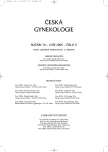Risk Factors Associated with High Birthweight Deliveries
Authors:
M. Větr
Authors‘ workplace:
Gynekologicko-porodnická klinika LF UP a FN, Olomouc, přednosta prof. MUDr. M. Kudela, CSc.
Published in:
Ceska Gynekol 2005; 70(5): 347-354
Category:
Original Article
Overview
Objective:
To examine the influence of possible risc factors, mainly abnormal pregravid maternal body habitus, age, education, parity and pregnancy complications (especially diabetes) on the prevalence of infants with fetal weight 4 000 grams and more. The study was also aimed to investigate pregnancy outcome among weight categories.
Study design:
Retrospective cohort study.
Setting:
Gynaecological and Obstetric Clinic Medical Faculty Palacky University and Faculty Hospital Olomouc.
Methods:
maternal and neonatal records for 7156 singleton deliveries of two fetal weight categories (2500–3999 grams and > 4 000 grams) during the 5-year period from 1. 1. 2000 to 31. 12. 2004 were reviewed. Univariate and multivariate analysis were performed. Multiple regression models, including maternal age, pregestational BMI (body mass index), education, smoking, alcohol consumption, IVF, anemia in pregnancy, preeclampsia, diabetes, gestational age, pregnancy weight gain, gender of the newborn were constructed to examine relative effect of these factors on the risk of the delivery of a big baby.
Results:
The prevalence of high birth weight infants was 10.8% in the study sample. There were 774 deliveries of infants birth weight category > 4000 g and 6382 deliveries of the babies 2500–3999 g. Significant risc factors from the univariate analysis were gestational age more than 40 weeks (18.2% vs 8.6%, P = 0.00000000), pregnancy weight gain over 13 kg (cutoff) (14.3% vs 7.5%, P = 0.00000000).
Compared with normal BMI subjects (19.8–25 kg/m2), obese women (BMI > 30 kg/m2) were at elevated risk for high birth weight delivery (18.1% vs 10.5%, P = 0.00000629) as were overweight women (BMI 25.1–30 kg/m2) (16.6% vs 10.5%, P = 0.00000004). Multiparity versus nulliparity (13.4% vs 8.1%, P = 0.00000000), male gender vs female (13.4% vs 8.0%, P = 0.00000). There were no significant difference with diabetes (12.6% vs 10.8%, P = 0.49089558). Smoking (5.4% vs 11.5%, P = 0.00000052) and low pregravid BMI (< 19.8 kg/m2) (5.7% vs 10.5%, P = 0.00000004) were associated with a lower risk of macrosomia
Multiple logistic regression revealed the independent influence of gestational age, pregnancy weight gain, abnormal maternal body habitus, multiparity, male gender and smoking on the fetal growth. Excess fetal weight affects delivery in higher frequency of active management of labor, induction (20.2% vs 16.6%, P = 0.01560228) and cesarean section (20.3 % vs 15.1%, P = 0.00021215). No significant differences were in prolongation of first and second stage of labor and frequency rate of operative vaginal deliveries.
No significant differences were noted between the groups regarding health status of live birth children.
Conclusion:
Gestational age over 40 weeks, increased pregnancy weight gain, pregravid maternal body habitus, multiparity and male gender are independent risk factors for high birthweight deliveries.
Key words:
pregnancy, macrosomia, BMI, pregnancy weight gain, risk, complications
Labels
Paediatric gynaecology Gynaecology and obstetrics Reproduction medicineArticle was published in
Czech Gynaecology

2005 Issue 5
Most read in this issue
- The Perineal Body Length and Injury at Delivery
- Embolization of Uterine Arteries during Myoma Treatment from the Patient’s Point of View
- Antifungal Effect in Selected Natural Compounds and Probiotics and their Possible Use in Prophylaxis of Vulvovaginitis
- Does Oocyte Retrieval Influence the Following Morphological Quality of Embryos?
